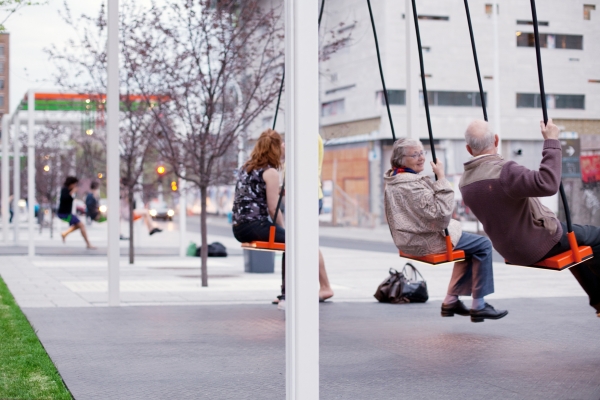
There is a photo I came across recently of people on swings near a public street that carried the caption “Bus Stop with Swings.” The photo is eye-catching because it’s out of the ordinary and playful in its depiction of an elderly couple on two of the swings. But like a lot of cool photos you find online these days it required a lengthy Google scavenger hunt to figure out 1. Where this so-called bus stop is located and 2. Anything else about the photo.
Welcome to the Tumblr internet, a world where reposting unoriginal content without any context is the norm, attribution is an afterthought and getting people to repost something you reposted is more important than actually having something interesting or original to say.
Absent any context, this photo I speak of had links below it to two Tumblr blogs or Tumblrs (I’m told the word tumblr is poised to become more popular than the word blog but I’m still waiting to see evidence of that), which subsequently sent me on a trip through dozens of other Tumblrs, all of them with almost identical content – “Bus Stop With Swings” and an occasional exclamation point, “awesome” or smiley face thrown in there for good measure.
Without realizing it at first, I had gotten stuck in a Tumblr vortex and the only way to get out was to start getting creative and patient in my searches. The first trail, buried beneath the avalanche of postings of the photo on Tumblr, led me to stories from 2008 about a London artist, Bruno Taylor, who installed some swing sets around the city as part of what he called his Playful Spaces project. The project matched the description but by the looks of what appeared to be the only photo from the project, one of a girl on a bus stop swing you don’t have to look hard to find, it didn’t look anything like the one making the rounds in 2012.
If Bruno Taylor wasn’t responsible for the photo, who was?
My answer finally came buried six pages into a web search in an article from a wonderful blog called Pop-Up City about swings in public places. Beginning with a description of the aforementioned Bruno Taylor project, the article chronicles several different efforts around the world to bring the childhood pastime to public spaces for people of all ages to enjoy. Talk about context.
Rounding out the list of projects was a mention of 21 Balançoires or 21 Swings as we English speakers would call it. Scrolling through images of the project I finally found the “Bus Stop with Swings” photo in its proper context. As it turns out, the location was near the University of Quebec in Montreal, the year was 2011 and the swings not only were not installed at a bus stop; they were much more than just swings. So much more.
Here’s how artists-designers Mouna Andraos and Melissa Mongiat describe the 2011 installation:
Together with Luc-Alain Giraldeau, an animal behaviour professor from the (University of Quebec) faculty, we explored the topic of cooperation which states that together we achieve better things than separately.
The result is a giant collective instrument made of 21 musical swings; each swing in motion triggers different notes, all the swings together compose a piece, but some sounds only emerge from cooperation. The project stimulates ownership of the new space, bringing together people of all ages and backgrounds, and creating a place for playing and hanging out in the middle of the city centre.
Musical swings? Social commentary on how we achieve better things together than apart? How incredible is that?
Wouldn’t it have been nice to have been provided some of this context in any of the hundreds of split-second reposts fired off by the Tumblr army with an inaccurate title and zero attribution to the incredible work by a couple of Canadian artists? You already know my answer to this question, or else I wouldn’t have conducted this little search and rescue mission in the first place.
But if you would allow me to sermonize a little this experience leads me to wonder how many other photos on Tumblr and Pinterest could tell a similar story if the people pinning and tumbling would take the time and be careful enough to seek out the stories behind the photos that show up in their feeds? At the risk of sounding like a grumpy old man yelling at a kid to get off my lawn (a portion of which I did actually plant new grass seed on in my real life last week), I do concede that the platforms are designed or at least used for rapid-fire, short attention span purposes and aren’t meant to be long, boring dissertations like the one I applaud you for still reading. I get that; that’s why I prefer blogs and RSS Readers, but I fear the YOLO generation with their constant FOMO concerns actually is missing out on the larger stories, the ones with contextual layers of beauty and truth that can only be found in careful exploration and attribution of the content creators who have taken the time to share their art with the world.
Not all of us are meant to be the creators and this very site you are on, like thousands everywhere you turn on the internet, demonstrates very little by way of original content. What it does do (I hope) is call attention to the ones who are sticking their necks out and taking the time to inform, question, challenge and entertain with their art while putting them in their proper and meaningful place.
Leave a Reply